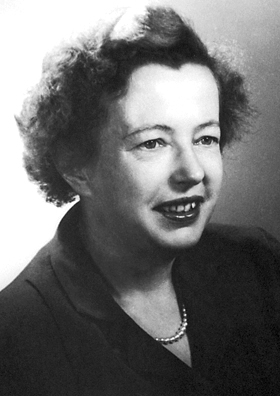
Maria Goeppert Mayer
Maria Goeppert Mayer (German pronunciation: [maˈʁiːa ˈɡœpɛʁt ˈmaɪ̯ɐ] , née Göppert; June 28, 1906 – February 20, 1972) was a German-born American theoretical physicist, and Nobel laureate in Physics for proposing the nuclear shell model of the atomic nucleus. She was the second woman to win a Nobel Prize in physics, the first being Marie Curie. In 1986, the Maria Goeppert-Mayer Award for early-career women physicists was established in her honor.
Maria Goeppert Mayer
February 20, 1972 (aged 65)
Germany
United States
2
Nobel Prize in Physics (1963)
A graduate of the University of Göttingen, Goeppert Mayer wrote her doctoral thesis on the theory of possible two-photon absorption by atoms. At the time, the chances of experimentally verifying her thesis seemed remote, but the development of the laser in the 1960s later permitted this. Today, the unit for the two-photon absorption cross section is named the Goeppert Mayer (GM) unit.
Maria Goeppert married chemist Joseph Edward Mayer and moved to the United States, where he was an associate professor at Johns Hopkins University. Strict rules against nepotism prevented Johns Hopkins University from taking her on as a faculty member, but she was given a job as an assistant and published a landmark paper on double beta decay in 1935. In 1937, she moved to Columbia University, where she took an unpaid position. During World War II, she worked for the Manhattan Project at Columbia on isotope separation, and with Edward Teller at the Los Alamos Laboratory on the development of thermonuclear weapons.
After the war, Goeppert Mayer became a voluntary associate professor of physics at the University of Chicago (where her husband and Teller worked) and a senior physicist at the university-run Argonne National Laboratory. She developed a mathematical model for the structure of nuclear shells, for which she was awarded the Nobel Prize in Physics in 1963, which she shared with J. Hans D. Jensen and Eugene Wigner. In 1960, she was appointed full professor of physics at the University of California, San Diego.
Early life[edit]
Maria Göppert was born on June 28, 1906, in Kattowitz (now Katowice, Poland), a Silesian city in the former Kingdom of Prussia, the only child of paediatrician Friedrich Göppert and his wife Maria née Wolff.[1] In 1910, she moved with her family to Göttingen when her father,[2] a sixth-generation university professor,[3] was appointed as the professor of pediatrics at the University of Göttingen.[1] Göppert was closer to her father than to her mother. "Well, my father was more interesting", she later explained. "He was after all a scientist".[4]
Göppert was educated at the Höhere Technische in Göttingen, a school for middle-class girls who aspired to higher education.[5] In 1921, she entered the Frauenstudium, a private high school run by suffragettes that aimed to prepare girls for university. She took the abitur, the university entrance examination, at age 17, a year early, with three or four girls from her school and thirty boys. All the girls passed, but only one of the boys did.[6]
In the spring of 1924, Göppert entered the University of Göttingen, where she studied mathematics.[7] She spent one year at Cambridge university, in England, before returning to Göttingen. A purported shortage of women mathematics teachers for schools for girls led to an upsurge of women studying mathematics at a time of high unemployment, and there was even a female professor of mathematics at Göttingen, Emmy Noether, but most were only interested in qualifying for their teaching certificates.[8]
Instead, Göppert became interested in physics, and chose to pursue a PhD. In her 1930 doctoral thesis[9][10] she worked out the theory of possible two-photon absorption by atoms.[7] Eugene Wigner later described the thesis as "a masterpiece of clarity and concreteness".[11] At the time, the chances of experimentally verifying her thesis seemed remote, but the development of the laser permitted the first experimental verification in 1961 when two-photon-excited fluorescence was detected in a europium-doped crystal.[12] To honor her fundamental contribution to this area, the unit for the two-photon absorption cross section is named the "GM". One GM is 10−50 cm4 s photon−1.[13] Her examiners were three Nobel prize winners: Max Born, James Franck and Adolf Otto Reinhold Windaus (in 1954, 1925, and 1928, respectively).[14] With Max Born she co-authored some important works on the lattice dynamics of crystals.
On January 19, 1930, Goeppert married Joseph Edward Mayer, an American Rockefeller fellow who was one of James Franck's assistants.[15][16] The two had met when Mayer had boarded with the Goeppert family.[17] The couple moved to Mayer's home country of the United States, where he had been offered a position as associate professor of chemistry at Johns Hopkins University.[18] They had two children, Maria Ann (who later married Donat Wentzel) and Peter Conrad.[15]